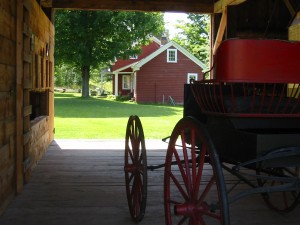What are these strange things called “homesites”?
Homesites is a term assumed by Laurafans (itself its own self-created term) to describe the places Laura lived throughout her life. All of these places have been commemorated in some way, whether in tiny or grandiose fashion. Although Little House Travel is full of information on these homesites, here’s a quick-and-dirty rundown, in the manner of The Least You Need to Know.
Some homesites are actually located a bit outside of the town they are traditionally associated with (like Malone, Independence, and Westville); for these purposes I will be referring to them by their most popular names.
The following homesites, all found in the Little House books, are listed chronologically as Laura lived there:
Pepin, Wisconsin. Laura and her sister Mary were born here; setting for Little House in the Big Woods, which begins when Laura is four years old.
Independence, Kansas. Little sister Carrie was born here. The Ingalls family spent about a year in what they called Indian Territory/Oklahoma Territory, although in truth they were just a few miles north of the Oklahoma border into Kansas. This is the setting for the book with the best-known title, Little House on the Prairie. (After this the family returned for a second stint in Wisconsin.)
Walnut Grove, Minnesota. When the Ingalls family moved (for the second time) from Wisconsin, they settled in Walnut Grove for a few years. Interestingly, the town is never named in On the Banks of Plum Creek, the book that describes these years.
De Smet, South Dakota. In 1879, when Laura was 12, the family made their last stop in the newly-formed town of De Smet, South Dakota. This town in southeastern South Dakota is the setting for more than half of the books in the series: By the Shores of Silver Lake, The Long Winter, Little Town on the Prairie, and These Happy Golden Years, whose final chapter depicts her marriage to Almanzo Wilder at age 18, effectively ending the Little House books. The posthumously published The First Four Years also takes place in De Smet.
Also mentioned in the series is Malone, New York, as recounted in Farmer Boy, the book that depicts the ninth and tenth years in the childhood of her husband, Almanzo. This book was published after Little House in the Big Woods at a time when both books were viewed as standalones. However, it is usually listed between Little House on the Prairie and On the Banks of Plum Creek (although it actually takes place around the time of Laura’s birth). Yeah, it’s confusing.
The following homesites are places Laura lived that are not written about in the series, again listed chronologically:
Burr Oak, Iowa. The Ingalls family lived here between two separate stays in Walnut Grove, Minnesota. Laura did not write about this town in the book series because it represented a sad time in her family’s life, though events from those years were used liberally in the TV series “Little House on the Prairie.”
Spring Valley, Minnesota. When Almanzo’s family moved from Malone, New York, they setted here. Laura, Almanzo, and their daughter Rose lived here for a time in their early married life.
Westville, Florida. Laura, Almanzo, and Rose lived here for less than a year, thinking it would help Almanzo’s health. Rose’s short story “Innocence,” which won an O. Henry award for fiction, recalls this time.
Mansfield, Missouri. In 1894, the family finally left De Smet for good. Laura was 27, and would spend the rest of her life in this town in Missouri. From here, she would write the Little House series. This homesite is also commonly referred to as “Rocky Ridge,” the name Laura gave to her home.
(The Ingalls family also spent a very brief time in Chariton County, Missouri, on their way from Wisconsin to Kansas.)


